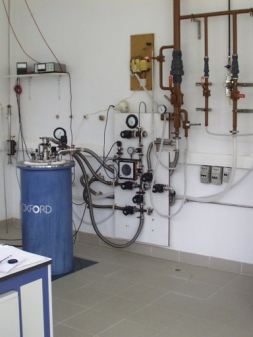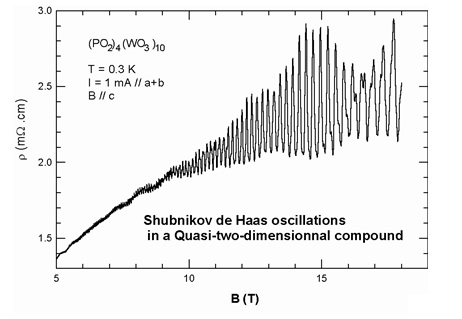Building for Cryogenic Techniques
(enter here to see map)
Among the several low temperature and high magnetic field facilities available, the cryostat with 18 T magnet offers the most extreme conditions and is specially dedicated to electrical transport measurements. Two different inserts can be fitted in this cryostat allowing either a temperature range from 1.6 K up to 300 K (4He flow) or from 0.3 K up to 300 K (3He cryostat).

Cryostat with 18T magnet.
The 4He insert is easy to use and various type of probe can be fitted. Our probes have been used for magnetotransport measurements in quasi-1D or 2D materials, in intermetallic compounds and in High Tc superconductors. A very precise rotating sample holder was built at the Nuclear and Technological Campus (CTN) to measure the variation of the magnetoresistance as a function of the angle between the magnetic field and the cristallographic axis or the electrical current. The angle is measured by an Hall sensor, the resolution is better than 0.01º. The rotation is obtained by a endless screw moved at room temperature by a step-by-step motor controlled by computer. This probes allows resistivity, magnetoresistivity and Hall effect measurements vs angle, vs temperature or vs magnetic field (1.6 K-300 K; 0-18 T). This probe is used to determine the anisotropy parameter in High Tc multilayers as a function of the angle between the magnetic field and the a,b plane (Fig. 1). Recently, a rotating cantilever magnetometer was installed, allowing magnetisation measurements up to 18 T in various directions.
The 3He insert is equipped with a rotating sample holder (0.02º precision, manually operated) for resistivity, magnetoresistivity and Hall effect. This probe was used to study localisation effects and Shubnikov-de Haas oscillations in quasi-2D materials (Fig. 2).

Figure 1: Rotating sample holder 1.6 K-300 K, 0-18T.Left: Resistivity of a YBaCuO/PrBaCuO multilayer as a function of the angle Q between the magnetic field B and the ab plane for various magnetic fields. Data obtained with the home-made rotating sample holder; Right: Verification of the scaling law for anisotropic superconductors: All the data of the left part are plotted as function of the reduced field: Bred==B(sin2Q+cos2Q /G2)1/2. The perfect superposition confirms the validity of this scaling law and allows the determination of the anisotropy parameter G.

Figure 2: Electrical transport at very low temperature Magnetoresistance of a quasi-two-dimensional compound at 0.3 K. The Fourier transform of these oscillations (Shubnikov-de Haas effect) allows the determination of the Fermi surface.
